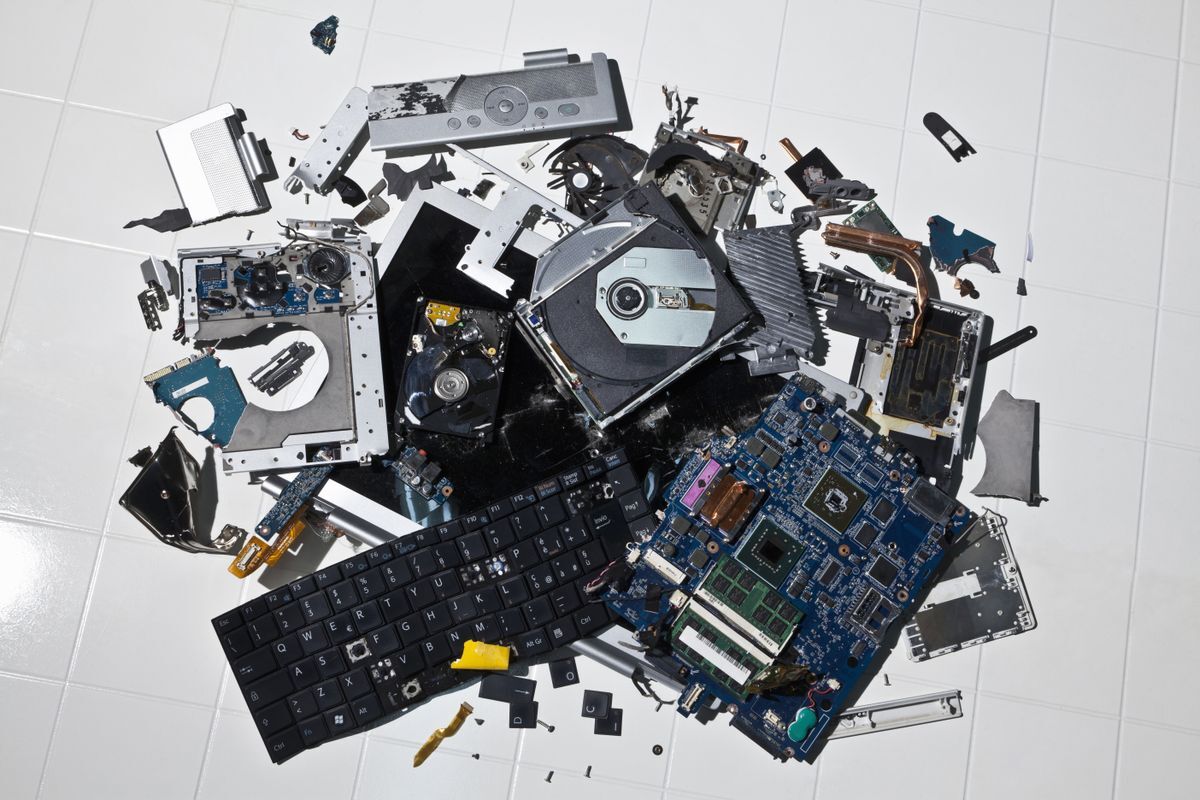- cross-posted to:
- [email protected]
- [email protected]
- cross-posted to:
- [email protected]
- [email protected]
Windows 10 end of life could prompt torrent of e-waste as 240 million devices set for scrapheap::As Windows 10 end of life approaches, analysts are concerned that millions of devices will be scrapped due to incompatibility
Great time to buy a cheap used PC for linux
Why cheap, why separate? Just use your current one and slap in another disk. I’ve been doing it for decades. Many games run surprisingly well in Linux, sometimes even better than windows
These Win10 EoLs are going to flood eBay at dirt cheap prices, and they make great server/project boxes. They’re going to be new toys for the hobbyist crowd, not primary machines.
Fair
I will just go take all 240 million of them out of the garbage.
I’ll lend you my truck.
You can have ten million computers as a treat
Neat! I can finally build a house out of computers.
Incompatibility with what? Things are only just starting to be incompatible with Windows 7. I’ve still got customers running variants of Windows XP.
And Windows 11 doesn’t really contain much that won’t work on 10.
I reckon the TPM and secure boot requirements will eventually be dropped. They’re the Kinect of Windows 11.
I’m still not even sure why they decided to require TPM anyways. But yeah my computer is among the many that can’t upgrade until that’s gone. I guess it’s either that or I learn a lot more about Linux…
At least if you switch to Linux there’s no shortage of people on the fediverse willing to answer questions.
There should be a “Linux hotline” community where people can post whatever is stopping them from switching and get solutions
Elsewhere, Linux support areas seem more likely than not to have a large contingent of “WHY ARE YOU ASKING A DUMB QUESTION, you horror of a human being? Why didn’t you Search the site for words you don’t know using our broken search engine, instead of infecting us with your congenital idiocy?” folks.
rtfm
I use Arch too!
Going the linux way can be troublesome at first, but you will be free from ms bullshit in the long run and will have your hardware lasting much longer. Unless you need something specific to windows for work, I recommend trying linux.
You’re probably not correct about TPM and secure boot being dropped. Microsoft’s entire enterprise line of security products including Intune and Defender for Endpoint are integrated to it and Microsoft Azure AD/Entra ID uses it for their certificate based enrollment and authentication. This is their primary profit drivers, not consumers.
Disabling the tpm requirement is just a registry hack in win 10, or a selectable option when creating an install usb with rufus.
I think they will make a simple calculation; What is going to cost more: The bad PR of nolonger updating 240 million pc’s, or accepting that a small portion of your users does not have tpm?
They haven’t stopped advanced users from installing win11 on older hardware so far. So no loss there. I also doubt they lose enterprise money if they allow win10 to upgrade regardless, as tpm is now well entrenched as the default on new hardware.
It’s just another scam for them to make money
Windows 10 should not require such a short life time. 11 isnt much different other than the security\TPM chip shit. And 11 is fucking terrible UX
Not to boast MS, but its service life is longer than Linux at 10 years. Lts on Linux is generally at best 8. Ltsc on Windows is much longer. Windows 10 released on 2015 and the ltsc ends at 2027 on the enterprise channel, or 2025 for the consumer general availability.
I’m only commenting because I dislike misinformation more than I dislike MS.
I like that it’s completely arbitrary and you can force windows 11 to install on unsupported hardware.
Also true… Windows 10 EOL is just planned obsolensence
You just need to set a couple of registry bypasses and you can upgrade any Computer to Windows 11. Downside is that some security features won’t work, but its not a big deal for consumers.
And what security features are these? Tpm? Lol.
In one sense, I’m glad they put this stupid barrier up so that I don’t have to keep deleting the forced upgrade as part of regular Windows Updates like I did with Win10, but on the other hand it’s bullshit that they’re creating so much waste for no other reason than personal profit for their company.
deleted by creator
Daily driving an unofficial windows mod is not a very good idea. For both privacy and stability reasons.
TPM 2.0 will be over 10 years old at that point, I’m pretty sure most of the hardware they’re talking about will have been retired by then no matter the support for Windows 10.
deleted by creator
I built a $1500 pc 6 years ago that doesn’t have a tpm. One gpu upgrade and this thing still does everything I want it for, including running modern games and VR with entirely acceptable performance. When windows 10 stops getting security updates, I’m just going to install arch on it.
It was on everything Intel starting in October 2017 (8th gen) and a year later it started on AMD’s consumer grade hardware with full integration in 2019 (3000 series)…
So 11 years after it started existing W10 stops receiving free updates, 10 years after the tech was fully integrated W10 stops receiving free and paid updates… And that’s not taking into consideration that W11 can still be installed on unsupported hardware…
I must have missed the cutoff by a couple of months. But here’s the thing: that cpu is still more than enough to drive 60fps on all the games I play, which includes typically demanding categories like fps, while running discord and YouTube and recording software. So the fact that Microsoft decided to fuck me over feels bad. TPM is garbage design from the hardware up, but I know to run secure workloads in secure places already.
The right thing to do should have been to force oem-licensed win11 to have TPM, and allowed retail versions to install with a pop up about security features which won’t be supported without it. Fuck Microsoft for not doing this obvious, simple thing.
It might be 10 years old, but it’s not widely deployed until a few years ago, just like how Wayland is 15 years old but only recently starting to see widespread use.
deleted by creator
So 240 million potential new Linux devices…? I see this as an absolute win!
Siempre esta la opcion de usar Linux y mantener activos esos equipos
I can’t upgrade to W11, I can’t afford nor am I ready to upgrade my gaming PC, its likely I’ll be moving to Linux or keeping to use W10 w/o support.
Microsoft really did no favors with limiting official W11 support. Its not just TPM.
I migrated to linux when Windows 7 died. So I’m you from years ago, lol.
If you’d like any advice, I would just say check ProtonDB for the games you regularly play (especially if they are MMOs) to make sure they work, cause anything that uses restrictive kernal level anticheats arent going to run.
and if you are looking for a distro, I would personally recommend Nobara. it stays up to date, it has a lot of the gaming stuff built in (Some of which might require compiling from github otherwise), and its been rock solid for me personally. but you should poke around and find whatever tickles your fancy… and anything you don’t get from X, that you can get from Y, can usually be manually installed on Z.
This obviously doesn’t solve any of the larger problem about MS pushing TPM, but you can bypass most of those W11 requirements.
Where can i get this waste .my linux pengiun will love it🤩.but it saddens me that people relay on windows so much.
This is corporate talk, no ones work station is going to be running Linux anytime soon.
Oh yeah everyone, tell me where you work with Linux?
Nobody’s Steam Deck is gonna run Windows any time soon.
Large ISP, in the global operations computing department. I am an exception to the rule though. I mostly touch network gear and *NIX servers so I’m not limited to Linux but I will say most of our *NIX stuff is RHEL now and doesn’t even boot past run level three so it’s all CLI.
I am fully on Linux - daily usage, gaming and working.
Our company doesnt usually allow linux other than our products. If we run a linux machine they want us to run this funky command that opens a backdoor for them lol after all the yearly trainings about how we arent supposed to do sketchy things like that. We still use linux machines because our windows machines are so locked down we cant do much with them but dont tell IT
Corporate IT requires a backdoor on all systems, the only thing sticking out is how automated they can make that on windows and macOS. And they do need that backdoor, so that they can check on and force patches so that you don’t end up with anyone else’s backdoor. Pretty reasonable when you really think about it.
Pretty crazy that my company does similar with Macs. When I started, my manager assigned me a Windows laptop, but it is so locked down that you can’t do anything technical. I eventually insisted on the Mac and life is easier simply because they let you do more
It’s 8 years old. FFS install Linux and have a little server or some shit if you really can’t be bothered to upgrade.
It’s corporations. My company is currently upgrading a shit ton of PCs before our windows 11 push.
Ok so if you built a computer in like 2019 or 2020 it’s only 4-5 years old. This was before windows 11 came out. 4-5 years is not that old for a computer, especially if you built a good one.
Nothing built in 19 doesn’t have tpm.
I have a ryzen 3800X and an x570 motherboard. It was one of the best motherboards at the time. No TPM support. You’re wrong.
Model and brand MB? 3800 had almost universal support so you’re almost certainly an edge case if you aren’t just incorrect.
Ryzen 7 3800X Asus ROG STRIX X570-E GAMING
Absolutely has TPM. User error.
Guess I need to enable in the bios. Windows 10 said I don’t have it lol. I must have disabled it cause I dual boot Linux.
the 3800X has a built in TPM… So yes. You have a TPM. TPMs don’t need to be discrete chips.
Needs to be supported by both cpu and motherboard, as far as I’m aware.
STRIX X570-E GAMING
https://kmpic.asus.com/images/2021/07/02/2ec2cf1d-0fee-4abe-bb99-b7c1e2cd4790.png
Enable it in bios. It’s not really a motherboard support option, but it needs to be initialized in BIOS(UEFI). It’s been mandated to be supported in Mobo’s for a long time now.
Edit: And because this is Lemmy… Or you could just not deal with it and use Linux :)
It’s also CPU generation, unless that’s changed since the last time I looked.
This is what happened to me, a really high end PC built in 2018 and I couldn’t even upgrade because of the TPM stuff! Decided to try out Zorin and have been pleasantly surprised.
9 times out of 10 you can turn TPM on on these machines, and even then, i’m told “Can’t upgrade to Windows 11.”
Been using Linux for years, it’s my daily driver and does everything I need except for a few headaches with a AAA game here or there, other than that it runs all my games does all my web browsing and all my video editing and other stuff without issues.
Haha, “bothered to upgrade”. What upgrade?
I have a 12 year old computer that runs Windows 10 perfectly fine.
There’s a lot of stuff that still doesn’t run on linux as far as I know.
Adobe suite is the only one I’ve encountered
If it runs Windows 10 - it runs Linux too.
I mean the software I’m running on Win 10. As far as I know, a lot of it still won’t run on linux.
Anyway, moot point since people said in this thread that you can bypass the TPM and Microsoft account requirements with Rufus. So anyone should be able to upgrade to Win 11.
Oh shit, I’ve been installing win 11 on a bunch of old hardware, didn’t realize what the big fuss was about it. I also use Rufus exclusively. Didn’t realize it was working so smoothly because I used Rufus haha
Huh. It’s almost as if Microsoft just wants more money from people buying a new computer with their new OS. No one could see that coming.
Yeah Microsoft is ripping EVERYONE off with a free upgrade 🙄
Bunch of nerds screaming over a free upgrade. Shocked.
The free upgrade part is not the thing that upsets me, if you even bothered to read the context. It’s the fact that you may not be able to upgrade an old machine to Windows 11 by “traditional means” (clicking a button), because Microsoft deems it “unsupported”, which the above commenter disproved by saying they were able to install it even on this “unsupported” hardware.
Don’t mean to disrespect, but I recommend you read the context before you start rolling your eyes and calling people names. Applies to real life too. Have a good day!
Another way to say this is the master race are about to upgrade their hardware
Or simply use an easy workaround to disable the tpm check and set up an offline account. I literally have win11 running on an old T460.
Anything you need to do beyond Rufus or the like for installation? How did activation, auto updates, etc work?
No, you don’t need anything else. Activation works the same if you log into your ms account or you can simply use https://massgrave.dev/ . I’m pretty sure there’s a way to get your key and enter it manually but I haven’t tried that yet.
Or upgrade to OS that gaben chosen
If only it ran the software and hardware I use…
Wine or emulation? When I had to use Windows for work I used WSL to run my tooling and didn’t notice any performance degradation. Does it apply too vice versa?
Although I’m with you on the hardware side. Because I have an Nvidia card my Linux install has been relegated for personal projects only. I already have a workstation supplied by my employer for work.
Sadly the things I need don’t work in Wine, Proton etc. I’m looking into running a Windows KVM with hardware pass through, but it’s quite the project, and requires a second GPU that I don’t have.
Curious what you’re using. Ms office kinda sucked but LibreOffice works incredibly well, and Adobe products last I tried (years ago) sucked. But gimp and DaVinci resolve work great. Most of my games run absolutely fine. For everything else you just need a web browser and those have worked great always.
Yeah office products and vide editors have Linux alternatives, but to me the main offenders are Native Instruments Maschine (proprietary USB controller that doesn’t work in Linux + software that doesn’t work in Linux) and DTP software like Affinity Publisher or Adobe Indesign that have no Linux equivalent.
I’m lookin into running those things in a Windows KVM in Linux though but it’s quite the project.
Ya that’s a tough one :(
Im still on a t430 🤷♀️
2013 Dell XPS i7-4470 up in this jawn.
Toshiba L745 i5 2430M here, still roaring
I don’t know how to install Windows 11 and I’m totally ok with it. I’ve been on linux for about 10 years.
Literally the same way, just takes 2000× longer.
Where does the assumption that owners of these devices care about updates comes from? I regularly see people still using Windows 7, willing to use sketchy workarounds to continue using it. We all wish that this would mean The Year Of The Linux Desktop in 2025, but that would mean users would have to suddenly start caring about their OS.
deleted by creator
Actually, that’s a real problem. The issue isn’t that features stop working or some slowdown, it’s millions of devices going without security updates and getting swooped into gargantuan bot networks.
How many non-tech people actually know about this? And how many of that small percentage are actually going to toss their computer as a result of it?
Because for the average computer user, they will never wonder why there are no more updates. And as long as their computer still browses the internet they don’t care even if you notify them.
Microsoft tried for years to get people off of fucking internet explorer and barely succeeded.
I expect there to be a lot of nagging. MS doesn’t want to miss out on all the Windows 11 licences they can sell with new hardware.
Do you really think that Microsoft is going to let these people exist in ignorant bliss?
You underestimate people’s ability to dismiss pop ups and notifications without retaining any of the information in them.
I’m definitely not, I work in IT 🤣 That doesn’t mean Microsoft won’t try.
Yeah, no one actually cares. Just look at phones, people don’t actually stop using them when they aren’t supported and don’t care as long as it keeps working.




















